Performance Compensation Management Case Study and Analysis
VerifiedAdded on 2019/10/30
|12
|2919
|257
Case Study
AI Summary
This assignment analyzes two case studies related to performance compensation management. The first case study examines the pros and cons of a pay openness policy, discussing its impact on employee motivation, fairness, and potential risks. The second case study, "WrapItUp," focuses on a restaurant chain facing issues with employee turnover, inconsistent brand image, and menu innovation. It analyzes the effectiveness of the "ShareIt" program, a quarterly profit-sharing plan implemented to increase manager retention. The analysis assesses the program's impact on store profits, manager performance, and employee satisfaction, providing insights into the program's successes and shortcomings. The assignment also explores the issues faced by the organization and the strategies adopted to improve the business. It explores the importance of fair pay policies, incentives, and the impact of employee turnover on the overall success of a business.
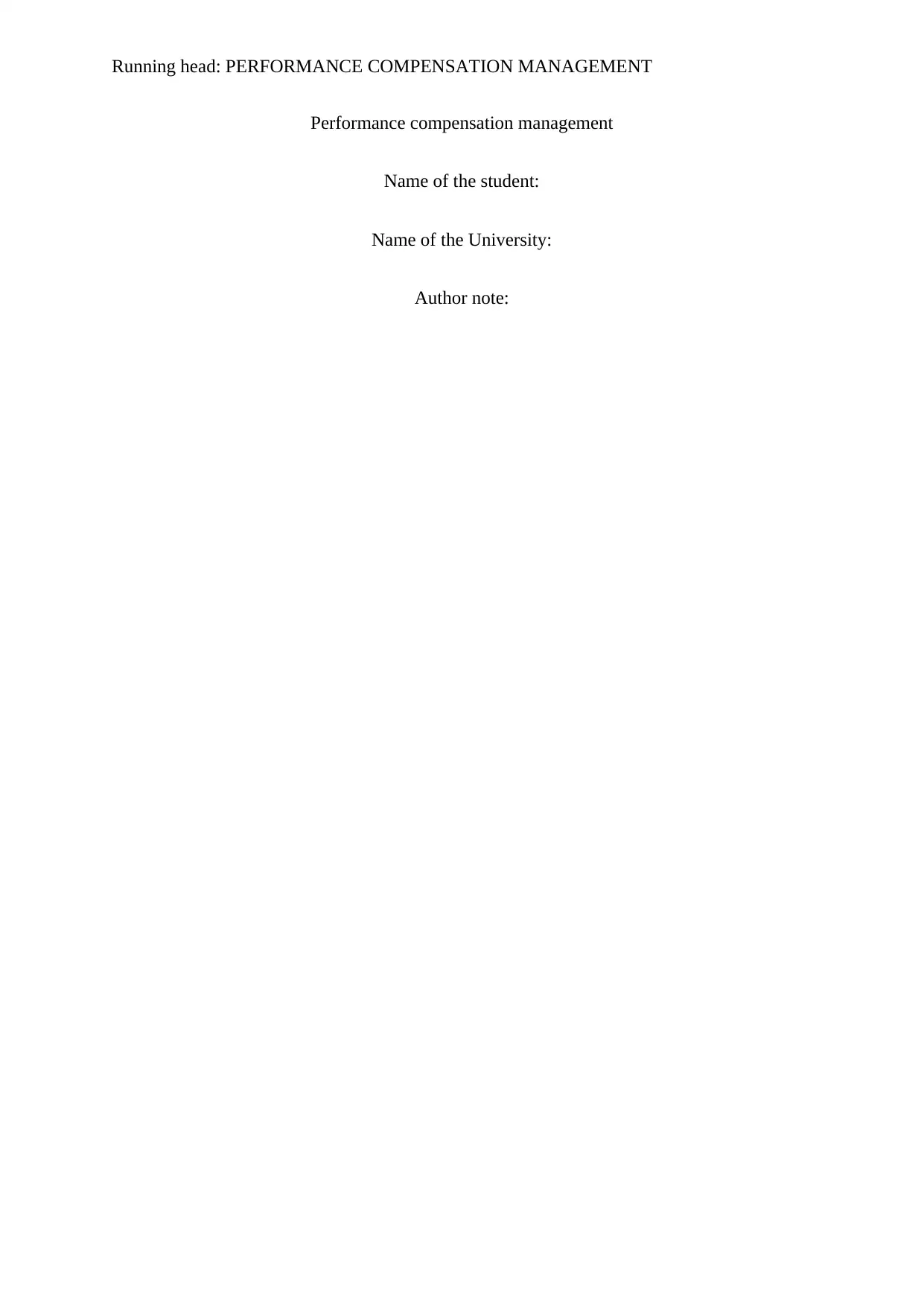
Running head: PERFORMANCE COMPENSATION MANAGEMENT
Performance compensation management
Name of the student:
Name of the University:
Author note:
Performance compensation management
Name of the student:
Name of the University:
Author note:
Paraphrase This Document
Need a fresh take? Get an instant paraphrase of this document with our AI Paraphraser
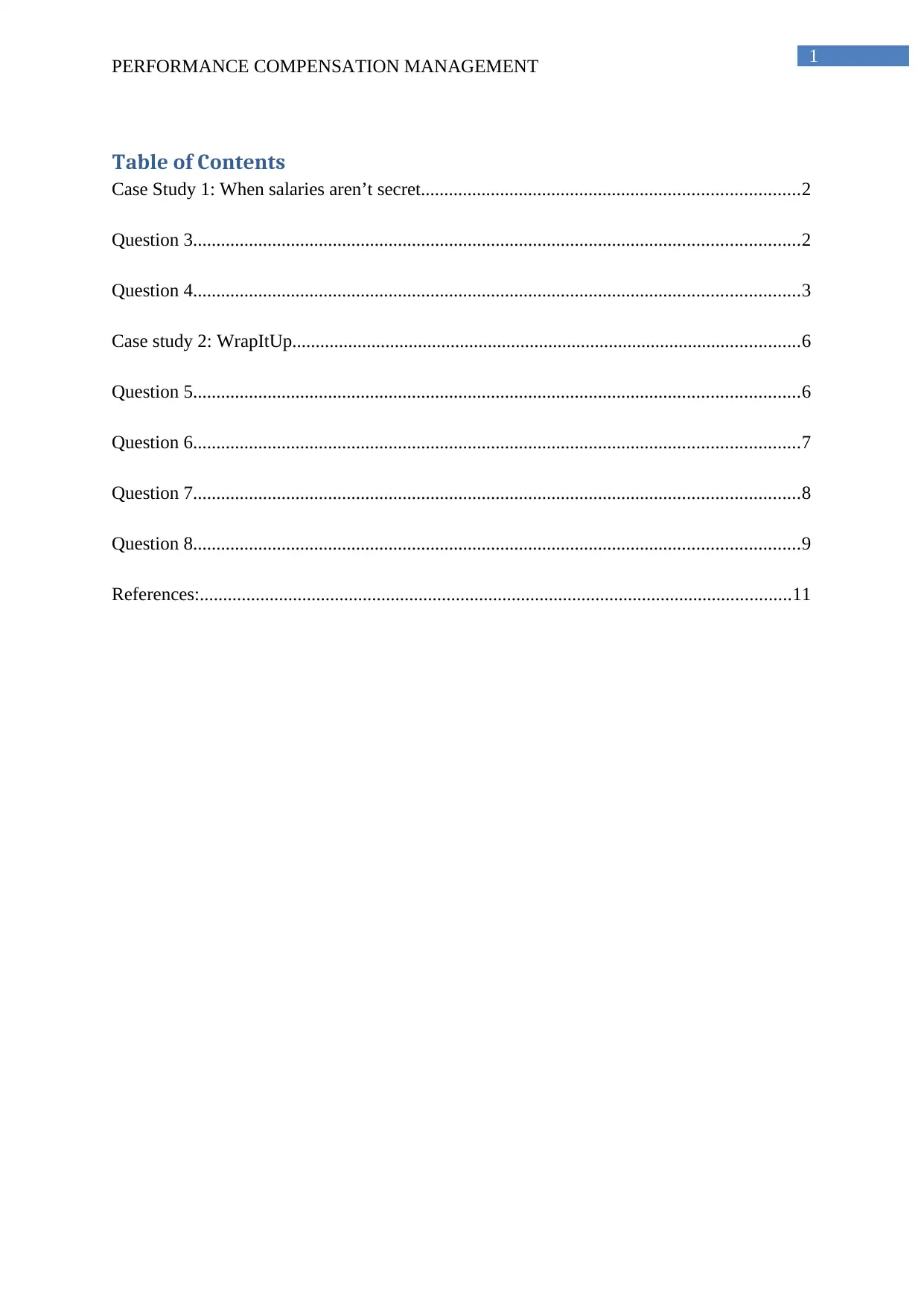
1
PERFORMANCE COMPENSATION MANAGEMENT
Table of Contents
Case Study 1: When salaries aren’t secret.................................................................................2
Question 3..................................................................................................................................2
Question 4..................................................................................................................................3
Case study 2: WrapItUp.............................................................................................................6
Question 5..................................................................................................................................6
Question 6..................................................................................................................................7
Question 7..................................................................................................................................8
Question 8..................................................................................................................................9
References:...............................................................................................................................11
PERFORMANCE COMPENSATION MANAGEMENT
Table of Contents
Case Study 1: When salaries aren’t secret.................................................................................2
Question 3..................................................................................................................................2
Question 4..................................................................................................................................3
Case study 2: WrapItUp.............................................................................................................6
Question 5..................................................................................................................................6
Question 6..................................................................................................................................7
Question 7..................................................................................................................................8
Question 8..................................................................................................................................9
References:...............................................................................................................................11
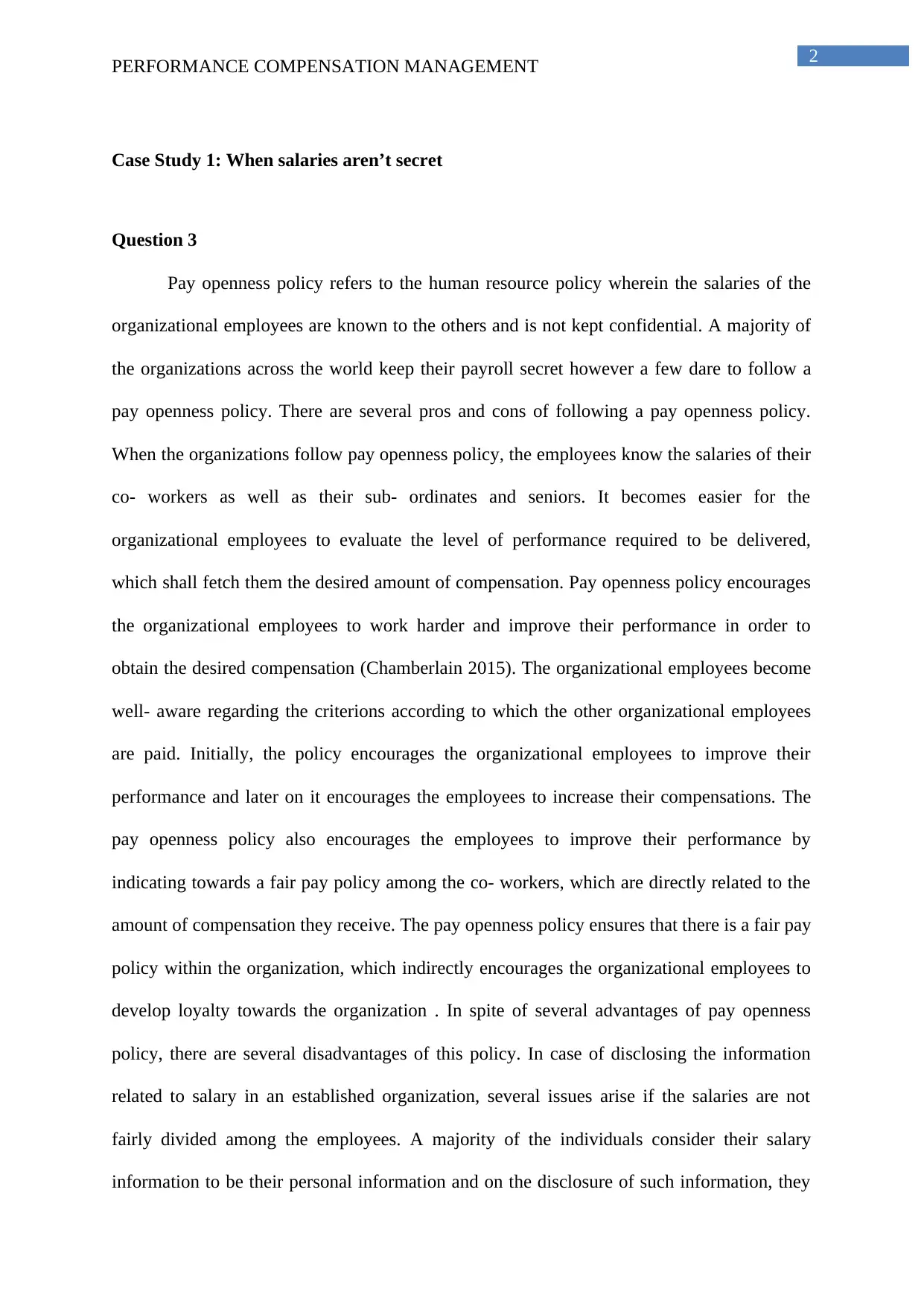
2
PERFORMANCE COMPENSATION MANAGEMENT
Case Study 1: When salaries aren’t secret
Question 3
Pay openness policy refers to the human resource policy wherein the salaries of the
organizational employees are known to the others and is not kept confidential. A majority of
the organizations across the world keep their payroll secret however a few dare to follow a
pay openness policy. There are several pros and cons of following a pay openness policy.
When the organizations follow pay openness policy, the employees know the salaries of their
co- workers as well as their sub- ordinates and seniors. It becomes easier for the
organizational employees to evaluate the level of performance required to be delivered,
which shall fetch them the desired amount of compensation. Pay openness policy encourages
the organizational employees to work harder and improve their performance in order to
obtain the desired compensation (Chamberlain 2015). The organizational employees become
well- aware regarding the criterions according to which the other organizational employees
are paid. Initially, the policy encourages the organizational employees to improve their
performance and later on it encourages the employees to increase their compensations. The
pay openness policy also encourages the employees to improve their performance by
indicating towards a fair pay policy among the co- workers, which are directly related to the
amount of compensation they receive. The pay openness policy ensures that there is a fair pay
policy within the organization, which indirectly encourages the organizational employees to
develop loyalty towards the organization . In spite of several advantages of pay openness
policy, there are several disadvantages of this policy. In case of disclosing the information
related to salary in an established organization, several issues arise if the salaries are not
fairly divided among the employees. A majority of the individuals consider their salary
information to be their personal information and on the disclosure of such information, they
PERFORMANCE COMPENSATION MANAGEMENT
Case Study 1: When salaries aren’t secret
Question 3
Pay openness policy refers to the human resource policy wherein the salaries of the
organizational employees are known to the others and is not kept confidential. A majority of
the organizations across the world keep their payroll secret however a few dare to follow a
pay openness policy. There are several pros and cons of following a pay openness policy.
When the organizations follow pay openness policy, the employees know the salaries of their
co- workers as well as their sub- ordinates and seniors. It becomes easier for the
organizational employees to evaluate the level of performance required to be delivered,
which shall fetch them the desired amount of compensation. Pay openness policy encourages
the organizational employees to work harder and improve their performance in order to
obtain the desired compensation (Chamberlain 2015). The organizational employees become
well- aware regarding the criterions according to which the other organizational employees
are paid. Initially, the policy encourages the organizational employees to improve their
performance and later on it encourages the employees to increase their compensations. The
pay openness policy also encourages the employees to improve their performance by
indicating towards a fair pay policy among the co- workers, which are directly related to the
amount of compensation they receive. The pay openness policy ensures that there is a fair pay
policy within the organization, which indirectly encourages the organizational employees to
develop loyalty towards the organization . In spite of several advantages of pay openness
policy, there are several disadvantages of this policy. In case of disclosing the information
related to salary in an established organization, several issues arise if the salaries are not
fairly divided among the employees. A majority of the individuals consider their salary
information to be their personal information and on the disclosure of such information, they
⊘ This is a preview!⊘
Do you want full access?
Subscribe today to unlock all pages.

Trusted by 1+ million students worldwide
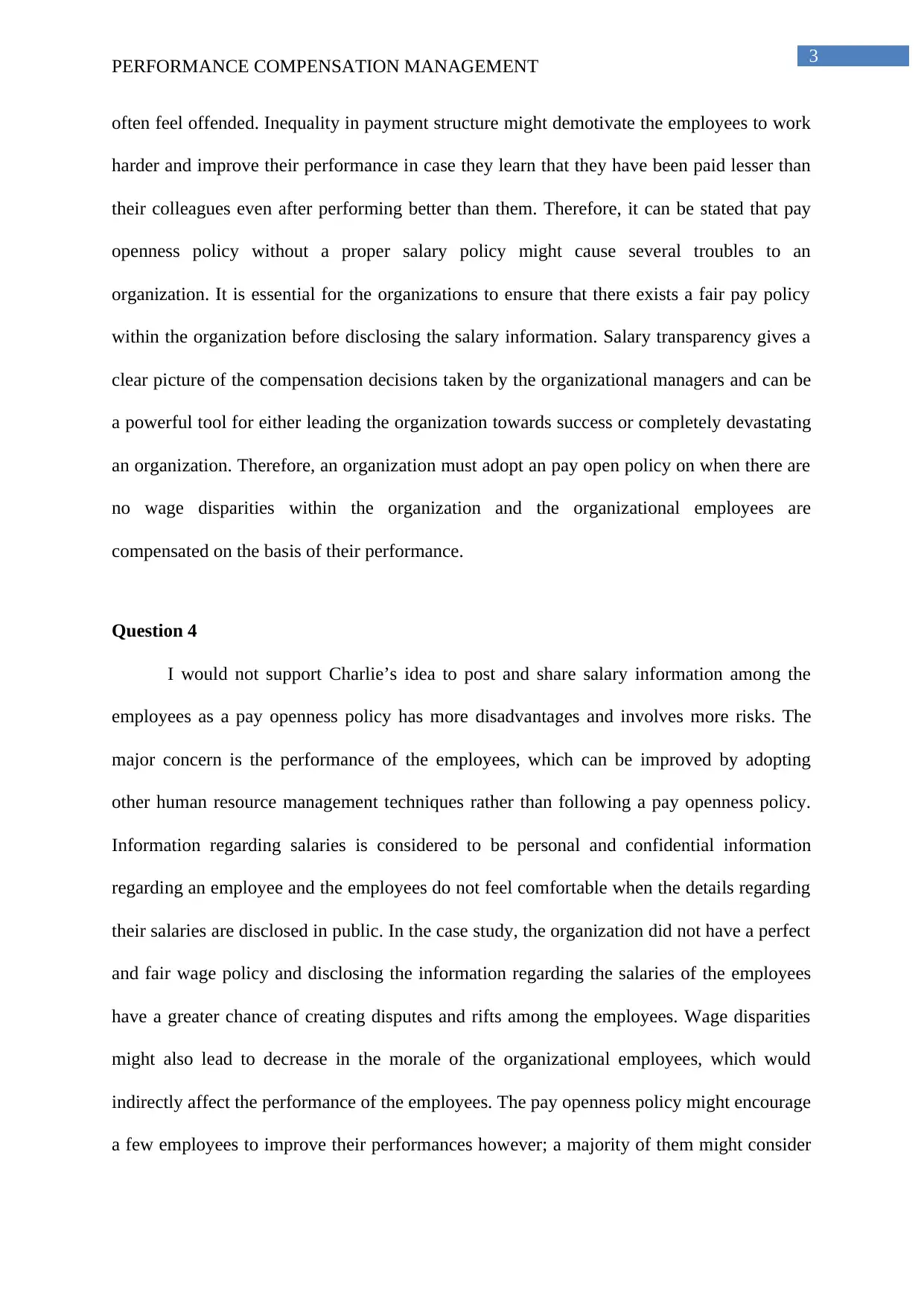
3
PERFORMANCE COMPENSATION MANAGEMENT
often feel offended. Inequality in payment structure might demotivate the employees to work
harder and improve their performance in case they learn that they have been paid lesser than
their colleagues even after performing better than them. Therefore, it can be stated that pay
openness policy without a proper salary policy might cause several troubles to an
organization. It is essential for the organizations to ensure that there exists a fair pay policy
within the organization before disclosing the salary information. Salary transparency gives a
clear picture of the compensation decisions taken by the organizational managers and can be
a powerful tool for either leading the organization towards success or completely devastating
an organization. Therefore, an organization must adopt an pay open policy on when there are
no wage disparities within the organization and the organizational employees are
compensated on the basis of their performance.
Question 4
I would not support Charlie’s idea to post and share salary information among the
employees as a pay openness policy has more disadvantages and involves more risks. The
major concern is the performance of the employees, which can be improved by adopting
other human resource management techniques rather than following a pay openness policy.
Information regarding salaries is considered to be personal and confidential information
regarding an employee and the employees do not feel comfortable when the details regarding
their salaries are disclosed in public. In the case study, the organization did not have a perfect
and fair wage policy and disclosing the information regarding the salaries of the employees
have a greater chance of creating disputes and rifts among the employees. Wage disparities
might also lead to decrease in the morale of the organizational employees, which would
indirectly affect the performance of the employees. The pay openness policy might encourage
a few employees to improve their performances however; a majority of them might consider
PERFORMANCE COMPENSATION MANAGEMENT
often feel offended. Inequality in payment structure might demotivate the employees to work
harder and improve their performance in case they learn that they have been paid lesser than
their colleagues even after performing better than them. Therefore, it can be stated that pay
openness policy without a proper salary policy might cause several troubles to an
organization. It is essential for the organizations to ensure that there exists a fair pay policy
within the organization before disclosing the salary information. Salary transparency gives a
clear picture of the compensation decisions taken by the organizational managers and can be
a powerful tool for either leading the organization towards success or completely devastating
an organization. Therefore, an organization must adopt an pay open policy on when there are
no wage disparities within the organization and the organizational employees are
compensated on the basis of their performance.
Question 4
I would not support Charlie’s idea to post and share salary information among the
employees as a pay openness policy has more disadvantages and involves more risks. The
major concern is the performance of the employees, which can be improved by adopting
other human resource management techniques rather than following a pay openness policy.
Information regarding salaries is considered to be personal and confidential information
regarding an employee and the employees do not feel comfortable when the details regarding
their salaries are disclosed in public. In the case study, the organization did not have a perfect
and fair wage policy and disclosing the information regarding the salaries of the employees
have a greater chance of creating disputes and rifts among the employees. Wage disparities
might also lead to decrease in the morale of the organizational employees, which would
indirectly affect the performance of the employees. The pay openness policy might encourage
a few employees to improve their performances however; a majority of them might consider
Paraphrase This Document
Need a fresh take? Get an instant paraphrase of this document with our AI Paraphraser

4
PERFORMANCE COMPENSATION MANAGEMENT
their salaries to be lower than their co- workers. Although, pay openness policy gives the
organizational employees greater negotiating power but a majority of the employees
emphasize more upon the salaries paid to their colleagues, who have the same expertise and
experience rather than evaluating their performance. Instead the performance of the
employees can be improved by providing them lucrative incentives and other fringe benefits
rather than adopting a pay openness policy. This would encourage the organizational
employees to improve their performance in order to achieve the targets that would fetch them
the desired incentives and benefits. This is a safer strategy for improving the organizational
performance than adopting a pay openness policy. Many a times, pay openness policy leads
to dissatisfaction and grudges among the employees and creates a negative environment
within an organization. This can directly affect the team spirit as the personal conflicts and
grudges shall discourage the organizational employees to cooperate with others and work
together for the achievement of the organizational objectives (Chamberlain 2015). The ideas
of Charlie are not entirely crazy, but it would have more disadvantages than advantages. Pay
openness policy can be cent percent successful only when the management is sure that there
are no income disparities within the organization or when they would be capable of satisfying
the queries of the organizational employees regarding the differences in the compensations.
Since, payroll is the highest expenses incurred by any organization, the organizations must be
careful while disclosing the confidential information especially in case of an established
organization. It is difficult to implement pay openness policy in an established organization
as the employees are comfortable with the payroll secrecy and sudden changes in the payroll
policy makes them worried and insecure. Additionally, this shall not only affect the internal
environment but shall also affect the position of the company in the market as the rival
companies might get the information regarding the salaries of the employees and might offer
better salaries to the employees, who have been performing well in the organization. This
PERFORMANCE COMPENSATION MANAGEMENT
their salaries to be lower than their co- workers. Although, pay openness policy gives the
organizational employees greater negotiating power but a majority of the employees
emphasize more upon the salaries paid to their colleagues, who have the same expertise and
experience rather than evaluating their performance. Instead the performance of the
employees can be improved by providing them lucrative incentives and other fringe benefits
rather than adopting a pay openness policy. This would encourage the organizational
employees to improve their performance in order to achieve the targets that would fetch them
the desired incentives and benefits. This is a safer strategy for improving the organizational
performance than adopting a pay openness policy. Many a times, pay openness policy leads
to dissatisfaction and grudges among the employees and creates a negative environment
within an organization. This can directly affect the team spirit as the personal conflicts and
grudges shall discourage the organizational employees to cooperate with others and work
together for the achievement of the organizational objectives (Chamberlain 2015). The ideas
of Charlie are not entirely crazy, but it would have more disadvantages than advantages. Pay
openness policy can be cent percent successful only when the management is sure that there
are no income disparities within the organization or when they would be capable of satisfying
the queries of the organizational employees regarding the differences in the compensations.
Since, payroll is the highest expenses incurred by any organization, the organizations must be
careful while disclosing the confidential information especially in case of an established
organization. It is difficult to implement pay openness policy in an established organization
as the employees are comfortable with the payroll secrecy and sudden changes in the payroll
policy makes them worried and insecure. Additionally, this shall not only affect the internal
environment but shall also affect the position of the company in the market as the rival
companies might get the information regarding the salaries of the employees and might offer
better salaries to the employees, who have been performing well in the organization. This
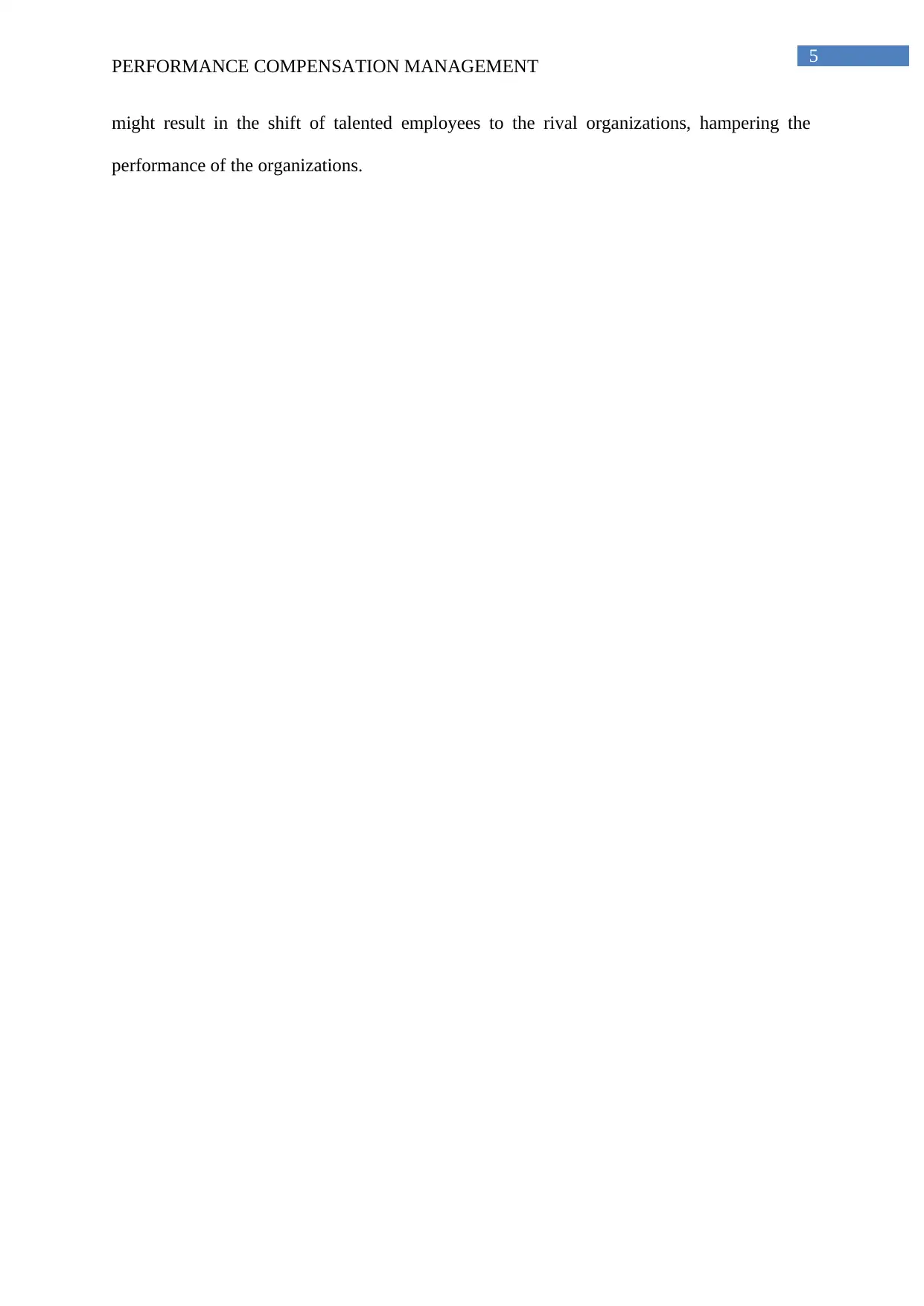
5
PERFORMANCE COMPENSATION MANAGEMENT
might result in the shift of talented employees to the rival organizations, hampering the
performance of the organizations.
PERFORMANCE COMPENSATION MANAGEMENT
might result in the shift of talented employees to the rival organizations, hampering the
performance of the organizations.
⊘ This is a preview!⊘
Do you want full access?
Subscribe today to unlock all pages.

Trusted by 1+ million students worldwide
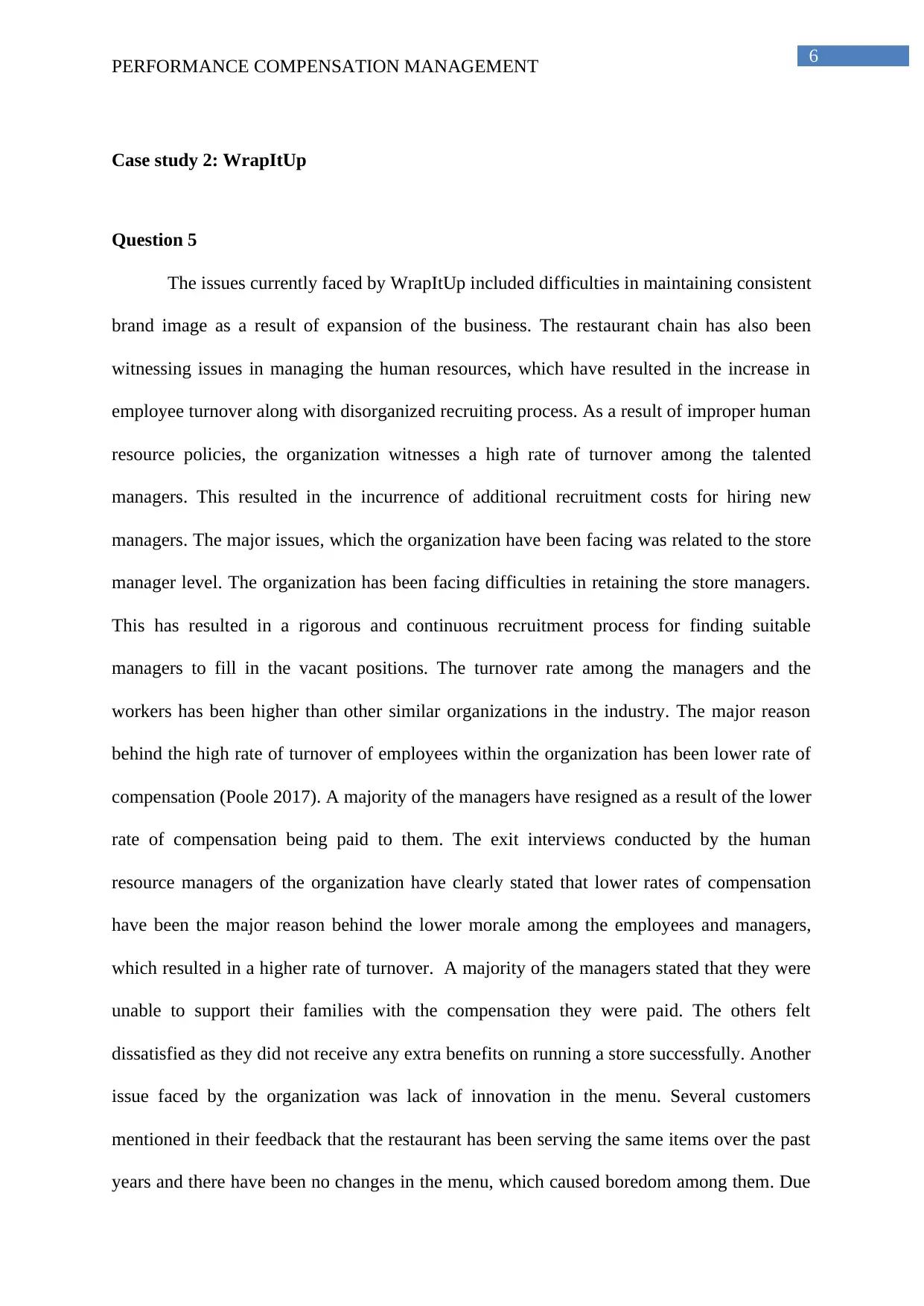
6
PERFORMANCE COMPENSATION MANAGEMENT
Case study 2: WrapItUp
Question 5
The issues currently faced by WrapItUp included difficulties in maintaining consistent
brand image as a result of expansion of the business. The restaurant chain has also been
witnessing issues in managing the human resources, which have resulted in the increase in
employee turnover along with disorganized recruiting process. As a result of improper human
resource policies, the organization witnesses a high rate of turnover among the talented
managers. This resulted in the incurrence of additional recruitment costs for hiring new
managers. The major issues, which the organization have been facing was related to the store
manager level. The organization has been facing difficulties in retaining the store managers.
This has resulted in a rigorous and continuous recruitment process for finding suitable
managers to fill in the vacant positions. The turnover rate among the managers and the
workers has been higher than other similar organizations in the industry. The major reason
behind the high rate of turnover of employees within the organization has been lower rate of
compensation (Poole 2017). A majority of the managers have resigned as a result of the lower
rate of compensation being paid to them. The exit interviews conducted by the human
resource managers of the organization have clearly stated that lower rates of compensation
have been the major reason behind the lower morale among the employees and managers,
which resulted in a higher rate of turnover. A majority of the managers stated that they were
unable to support their families with the compensation they were paid. The others felt
dissatisfied as they did not receive any extra benefits on running a store successfully. Another
issue faced by the organization was lack of innovation in the menu. Several customers
mentioned in their feedback that the restaurant has been serving the same items over the past
years and there have been no changes in the menu, which caused boredom among them. Due
PERFORMANCE COMPENSATION MANAGEMENT
Case study 2: WrapItUp
Question 5
The issues currently faced by WrapItUp included difficulties in maintaining consistent
brand image as a result of expansion of the business. The restaurant chain has also been
witnessing issues in managing the human resources, which have resulted in the increase in
employee turnover along with disorganized recruiting process. As a result of improper human
resource policies, the organization witnesses a high rate of turnover among the talented
managers. This resulted in the incurrence of additional recruitment costs for hiring new
managers. The major issues, which the organization have been facing was related to the store
manager level. The organization has been facing difficulties in retaining the store managers.
This has resulted in a rigorous and continuous recruitment process for finding suitable
managers to fill in the vacant positions. The turnover rate among the managers and the
workers has been higher than other similar organizations in the industry. The major reason
behind the high rate of turnover of employees within the organization has been lower rate of
compensation (Poole 2017). A majority of the managers have resigned as a result of the lower
rate of compensation being paid to them. The exit interviews conducted by the human
resource managers of the organization have clearly stated that lower rates of compensation
have been the major reason behind the lower morale among the employees and managers,
which resulted in a higher rate of turnover. A majority of the managers stated that they were
unable to support their families with the compensation they were paid. The others felt
dissatisfied as they did not receive any extra benefits on running a store successfully. Another
issue faced by the organization was lack of innovation in the menu. Several customers
mentioned in their feedback that the restaurant has been serving the same items over the past
years and there have been no changes in the menu, which caused boredom among them. Due
Paraphrase This Document
Need a fresh take? Get an instant paraphrase of this document with our AI Paraphraser
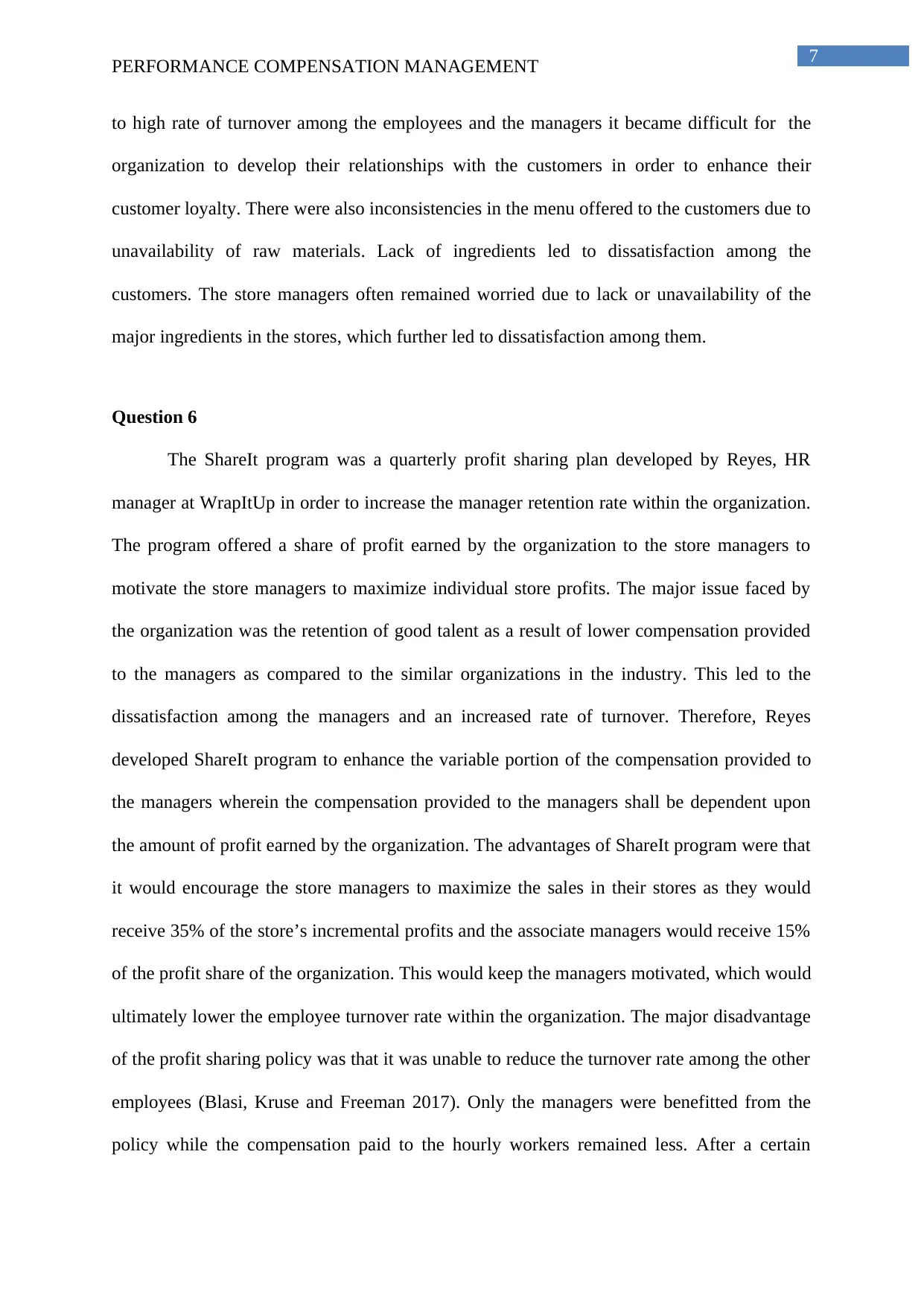
7
PERFORMANCE COMPENSATION MANAGEMENT
to high rate of turnover among the employees and the managers it became difficult for the
organization to develop their relationships with the customers in order to enhance their
customer loyalty. There were also inconsistencies in the menu offered to the customers due to
unavailability of raw materials. Lack of ingredients led to dissatisfaction among the
customers. The store managers often remained worried due to lack or unavailability of the
major ingredients in the stores, which further led to dissatisfaction among them.
Question 6
The ShareIt program was a quarterly profit sharing plan developed by Reyes, HR
manager at WrapItUp in order to increase the manager retention rate within the organization.
The program offered a share of profit earned by the organization to the store managers to
motivate the store managers to maximize individual store profits. The major issue faced by
the organization was the retention of good talent as a result of lower compensation provided
to the managers as compared to the similar organizations in the industry. This led to the
dissatisfaction among the managers and an increased rate of turnover. Therefore, Reyes
developed ShareIt program to enhance the variable portion of the compensation provided to
the managers wherein the compensation provided to the managers shall be dependent upon
the amount of profit earned by the organization. The advantages of ShareIt program were that
it would encourage the store managers to maximize the sales in their stores as they would
receive 35% of the store’s incremental profits and the associate managers would receive 15%
of the profit share of the organization. This would keep the managers motivated, which would
ultimately lower the employee turnover rate within the organization. The major disadvantage
of the profit sharing policy was that it was unable to reduce the turnover rate among the other
employees (Blasi, Kruse and Freeman 2017). Only the managers were benefitted from the
policy while the compensation paid to the hourly workers remained less. After a certain
PERFORMANCE COMPENSATION MANAGEMENT
to high rate of turnover among the employees and the managers it became difficult for the
organization to develop their relationships with the customers in order to enhance their
customer loyalty. There were also inconsistencies in the menu offered to the customers due to
unavailability of raw materials. Lack of ingredients led to dissatisfaction among the
customers. The store managers often remained worried due to lack or unavailability of the
major ingredients in the stores, which further led to dissatisfaction among them.
Question 6
The ShareIt program was a quarterly profit sharing plan developed by Reyes, HR
manager at WrapItUp in order to increase the manager retention rate within the organization.
The program offered a share of profit earned by the organization to the store managers to
motivate the store managers to maximize individual store profits. The major issue faced by
the organization was the retention of good talent as a result of lower compensation provided
to the managers as compared to the similar organizations in the industry. This led to the
dissatisfaction among the managers and an increased rate of turnover. Therefore, Reyes
developed ShareIt program to enhance the variable portion of the compensation provided to
the managers wherein the compensation provided to the managers shall be dependent upon
the amount of profit earned by the organization. The advantages of ShareIt program were that
it would encourage the store managers to maximize the sales in their stores as they would
receive 35% of the store’s incremental profits and the associate managers would receive 15%
of the profit share of the organization. This would keep the managers motivated, which would
ultimately lower the employee turnover rate within the organization. The major disadvantage
of the profit sharing policy was that it was unable to reduce the turnover rate among the other
employees (Blasi, Kruse and Freeman 2017). Only the managers were benefitted from the
policy while the compensation paid to the hourly workers remained less. After a certain

8
PERFORMANCE COMPENSATION MANAGEMENT
period of time, the profit sharing becomes an entitlement rather than a factor of motivation.
The higher level managers are only benefitted from such policies while the other workers are
refrained from deriving benefits from profit sharing programs. However, the efforts of the
workers actually help the businesses to grow as they directly deal with the customers while
the managers enjoy the benefits of profit sharing, which increases the grievances among the
workers. In case of ShareIt program also, the managers derived benefits while the other
workers were refrained from obtaining those benefits.
Question 7
Considering the results achieved by the two pilot stores namely the Santa Monica
restaurant and the Costa Mesa restaurant it can be stated that ShareIt program was successful
and it achieved the set goals. Both the restaurants had witnessed an increase in the overall
profits. The performance of the managers had improved along with the compensation earned
by them. The program led to an increase in the retention rate among the managers along with
more satisfied managers. The managers had put in their extra efforts and innovations to
increase the profitability of their stores. The store manager at Santa Monica took the help of
Facebook and Twitter to attract more customers. She provided special offers and discounts to
increase the sales and designed an online ordering system to add to the convenience of the
customers. She visited several offices during the lunch time and promoted her restaurant. All
these additional efforts led to an increase in the sales and profits of the store. On the other
hand, the store manager at Costa Mesa negotiated with the suppliers of raw materials to
reduce the costs incurred on the procurement of raw materials. The managers were observed
to work for 70 hours per week which was previously 50 hours per week. The managers at
Costa Mesa tried to save the costs incurred by lowering workers hourly labor by preparing
food themselves, taking orders and washing equipments. All the extra efforts put in by the
PERFORMANCE COMPENSATION MANAGEMENT
period of time, the profit sharing becomes an entitlement rather than a factor of motivation.
The higher level managers are only benefitted from such policies while the other workers are
refrained from deriving benefits from profit sharing programs. However, the efforts of the
workers actually help the businesses to grow as they directly deal with the customers while
the managers enjoy the benefits of profit sharing, which increases the grievances among the
workers. In case of ShareIt program also, the managers derived benefits while the other
workers were refrained from obtaining those benefits.
Question 7
Considering the results achieved by the two pilot stores namely the Santa Monica
restaurant and the Costa Mesa restaurant it can be stated that ShareIt program was successful
and it achieved the set goals. Both the restaurants had witnessed an increase in the overall
profits. The performance of the managers had improved along with the compensation earned
by them. The program led to an increase in the retention rate among the managers along with
more satisfied managers. The managers had put in their extra efforts and innovations to
increase the profitability of their stores. The store manager at Santa Monica took the help of
Facebook and Twitter to attract more customers. She provided special offers and discounts to
increase the sales and designed an online ordering system to add to the convenience of the
customers. She visited several offices during the lunch time and promoted her restaurant. All
these additional efforts led to an increase in the sales and profits of the store. On the other
hand, the store manager at Costa Mesa negotiated with the suppliers of raw materials to
reduce the costs incurred on the procurement of raw materials. The managers were observed
to work for 70 hours per week which was previously 50 hours per week. The managers at
Costa Mesa tried to save the costs incurred by lowering workers hourly labor by preparing
food themselves, taking orders and washing equipments. All the extra efforts put in by the
⊘ This is a preview!⊘
Do you want full access?
Subscribe today to unlock all pages.

Trusted by 1+ million students worldwide
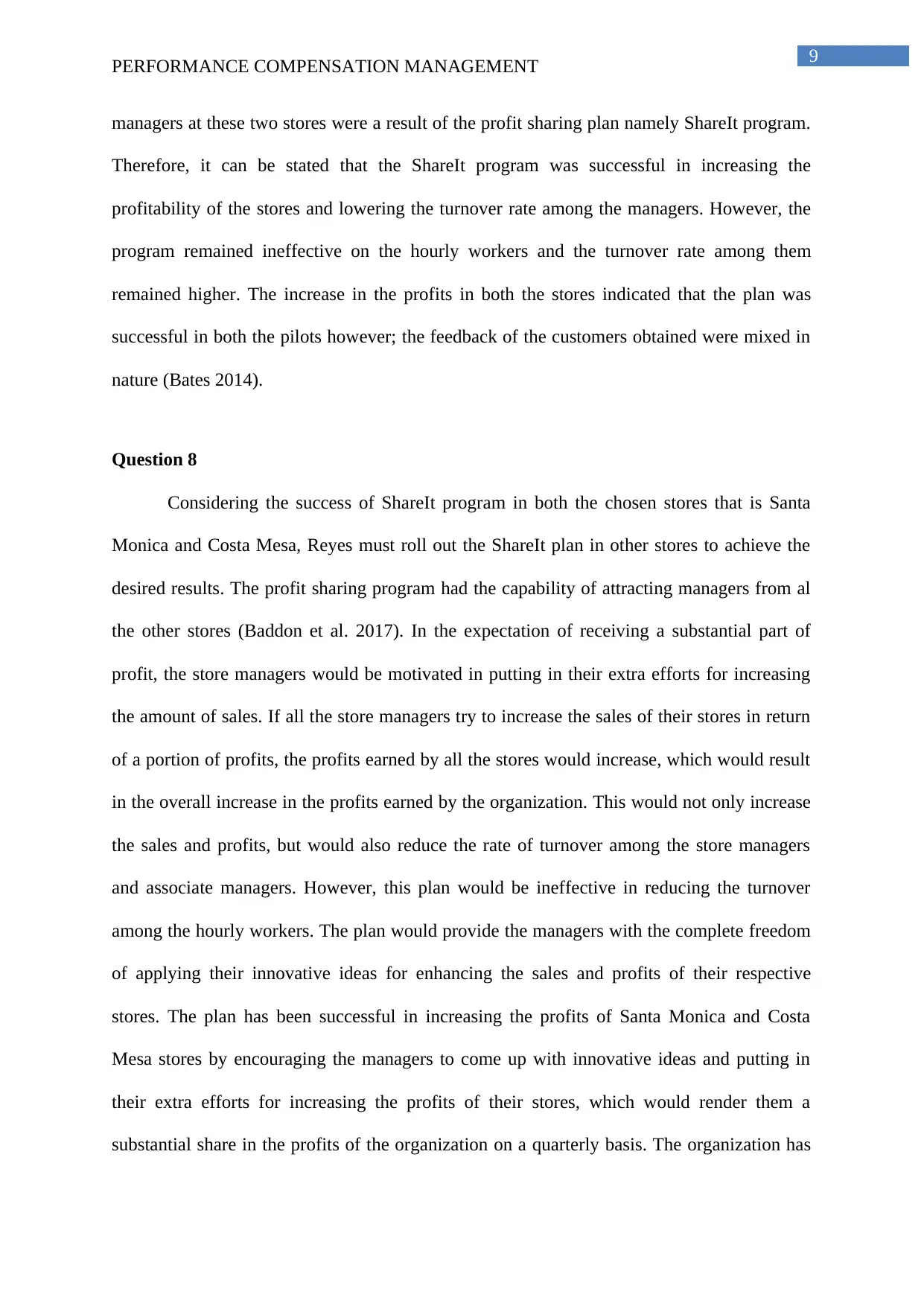
9
PERFORMANCE COMPENSATION MANAGEMENT
managers at these two stores were a result of the profit sharing plan namely ShareIt program.
Therefore, it can be stated that the ShareIt program was successful in increasing the
profitability of the stores and lowering the turnover rate among the managers. However, the
program remained ineffective on the hourly workers and the turnover rate among them
remained higher. The increase in the profits in both the stores indicated that the plan was
successful in both the pilots however; the feedback of the customers obtained were mixed in
nature (Bates 2014).
Question 8
Considering the success of ShareIt program in both the chosen stores that is Santa
Monica and Costa Mesa, Reyes must roll out the ShareIt plan in other stores to achieve the
desired results. The profit sharing program had the capability of attracting managers from al
the other stores (Baddon et al. 2017). In the expectation of receiving a substantial part of
profit, the store managers would be motivated in putting in their extra efforts for increasing
the amount of sales. If all the store managers try to increase the sales of their stores in return
of a portion of profits, the profits earned by all the stores would increase, which would result
in the overall increase in the profits earned by the organization. This would not only increase
the sales and profits, but would also reduce the rate of turnover among the store managers
and associate managers. However, this plan would be ineffective in reducing the turnover
among the hourly workers. The plan would provide the managers with the complete freedom
of applying their innovative ideas for enhancing the sales and profits of their respective
stores. The plan has been successful in increasing the profits of Santa Monica and Costa
Mesa stores by encouraging the managers to come up with innovative ideas and putting in
their extra efforts for increasing the profits of their stores, which would render them a
substantial share in the profits of the organization on a quarterly basis. The organization has
PERFORMANCE COMPENSATION MANAGEMENT
managers at these two stores were a result of the profit sharing plan namely ShareIt program.
Therefore, it can be stated that the ShareIt program was successful in increasing the
profitability of the stores and lowering the turnover rate among the managers. However, the
program remained ineffective on the hourly workers and the turnover rate among them
remained higher. The increase in the profits in both the stores indicated that the plan was
successful in both the pilots however; the feedback of the customers obtained were mixed in
nature (Bates 2014).
Question 8
Considering the success of ShareIt program in both the chosen stores that is Santa
Monica and Costa Mesa, Reyes must roll out the ShareIt plan in other stores to achieve the
desired results. The profit sharing program had the capability of attracting managers from al
the other stores (Baddon et al. 2017). In the expectation of receiving a substantial part of
profit, the store managers would be motivated in putting in their extra efforts for increasing
the amount of sales. If all the store managers try to increase the sales of their stores in return
of a portion of profits, the profits earned by all the stores would increase, which would result
in the overall increase in the profits earned by the organization. This would not only increase
the sales and profits, but would also reduce the rate of turnover among the store managers
and associate managers. However, this plan would be ineffective in reducing the turnover
among the hourly workers. The plan would provide the managers with the complete freedom
of applying their innovative ideas for enhancing the sales and profits of their respective
stores. The plan has been successful in increasing the profits of Santa Monica and Costa
Mesa stores by encouraging the managers to come up with innovative ideas and putting in
their extra efforts for increasing the profits of their stores, which would render them a
substantial share in the profits of the organization on a quarterly basis. The organization has
Paraphrase This Document
Need a fresh take? Get an instant paraphrase of this document with our AI Paraphraser
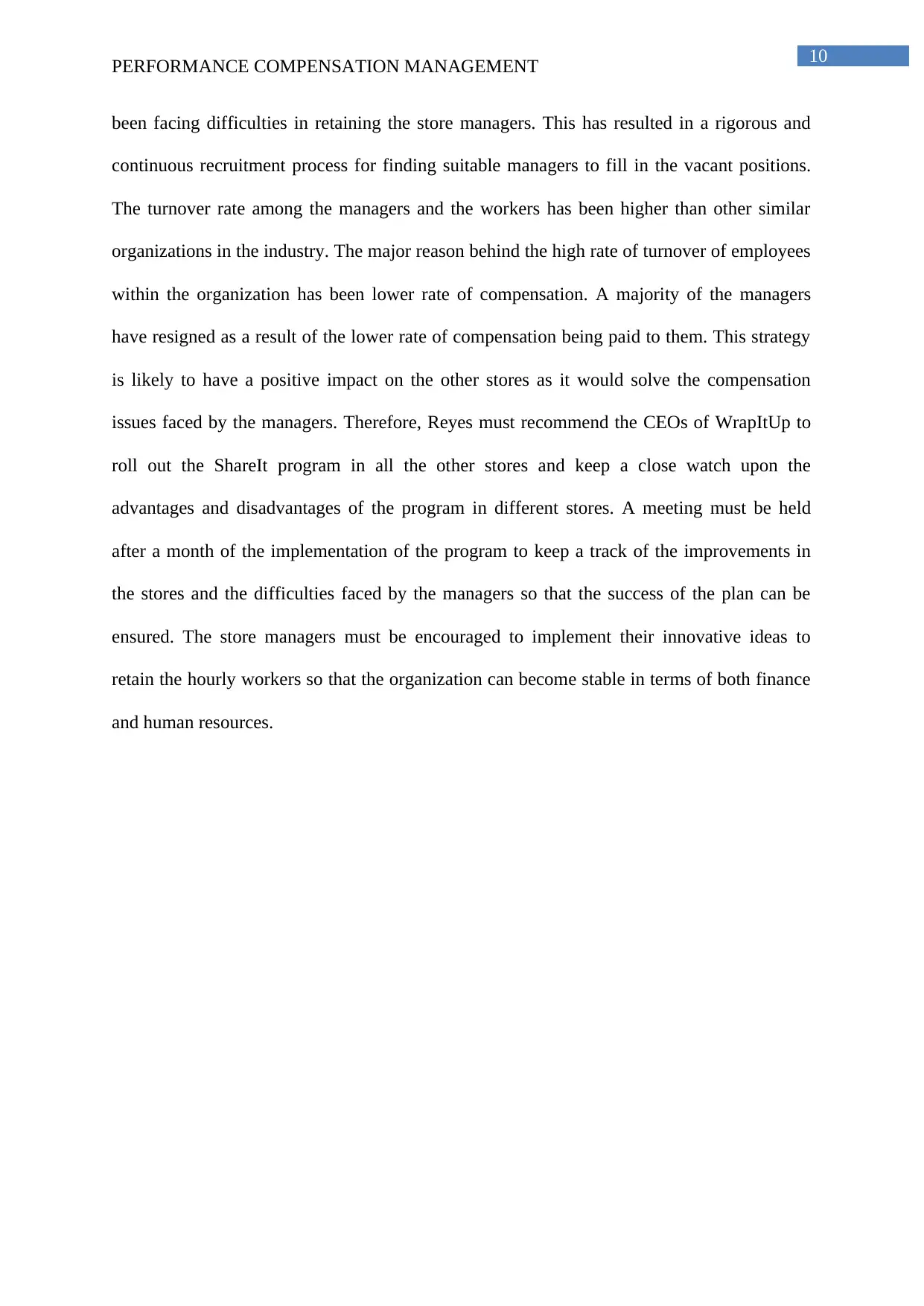
10
PERFORMANCE COMPENSATION MANAGEMENT
been facing difficulties in retaining the store managers. This has resulted in a rigorous and
continuous recruitment process for finding suitable managers to fill in the vacant positions.
The turnover rate among the managers and the workers has been higher than other similar
organizations in the industry. The major reason behind the high rate of turnover of employees
within the organization has been lower rate of compensation. A majority of the managers
have resigned as a result of the lower rate of compensation being paid to them. This strategy
is likely to have a positive impact on the other stores as it would solve the compensation
issues faced by the managers. Therefore, Reyes must recommend the CEOs of WrapItUp to
roll out the ShareIt program in all the other stores and keep a close watch upon the
advantages and disadvantages of the program in different stores. A meeting must be held
after a month of the implementation of the program to keep a track of the improvements in
the stores and the difficulties faced by the managers so that the success of the plan can be
ensured. The store managers must be encouraged to implement their innovative ideas to
retain the hourly workers so that the organization can become stable in terms of both finance
and human resources.
PERFORMANCE COMPENSATION MANAGEMENT
been facing difficulties in retaining the store managers. This has resulted in a rigorous and
continuous recruitment process for finding suitable managers to fill in the vacant positions.
The turnover rate among the managers and the workers has been higher than other similar
organizations in the industry. The major reason behind the high rate of turnover of employees
within the organization has been lower rate of compensation. A majority of the managers
have resigned as a result of the lower rate of compensation being paid to them. This strategy
is likely to have a positive impact on the other stores as it would solve the compensation
issues faced by the managers. Therefore, Reyes must recommend the CEOs of WrapItUp to
roll out the ShareIt program in all the other stores and keep a close watch upon the
advantages and disadvantages of the program in different stores. A meeting must be held
after a month of the implementation of the program to keep a track of the improvements in
the stores and the difficulties faced by the managers so that the success of the plan can be
ensured. The store managers must be encouraged to implement their innovative ideas to
retain the hourly workers so that the organization can become stable in terms of both finance
and human resources.
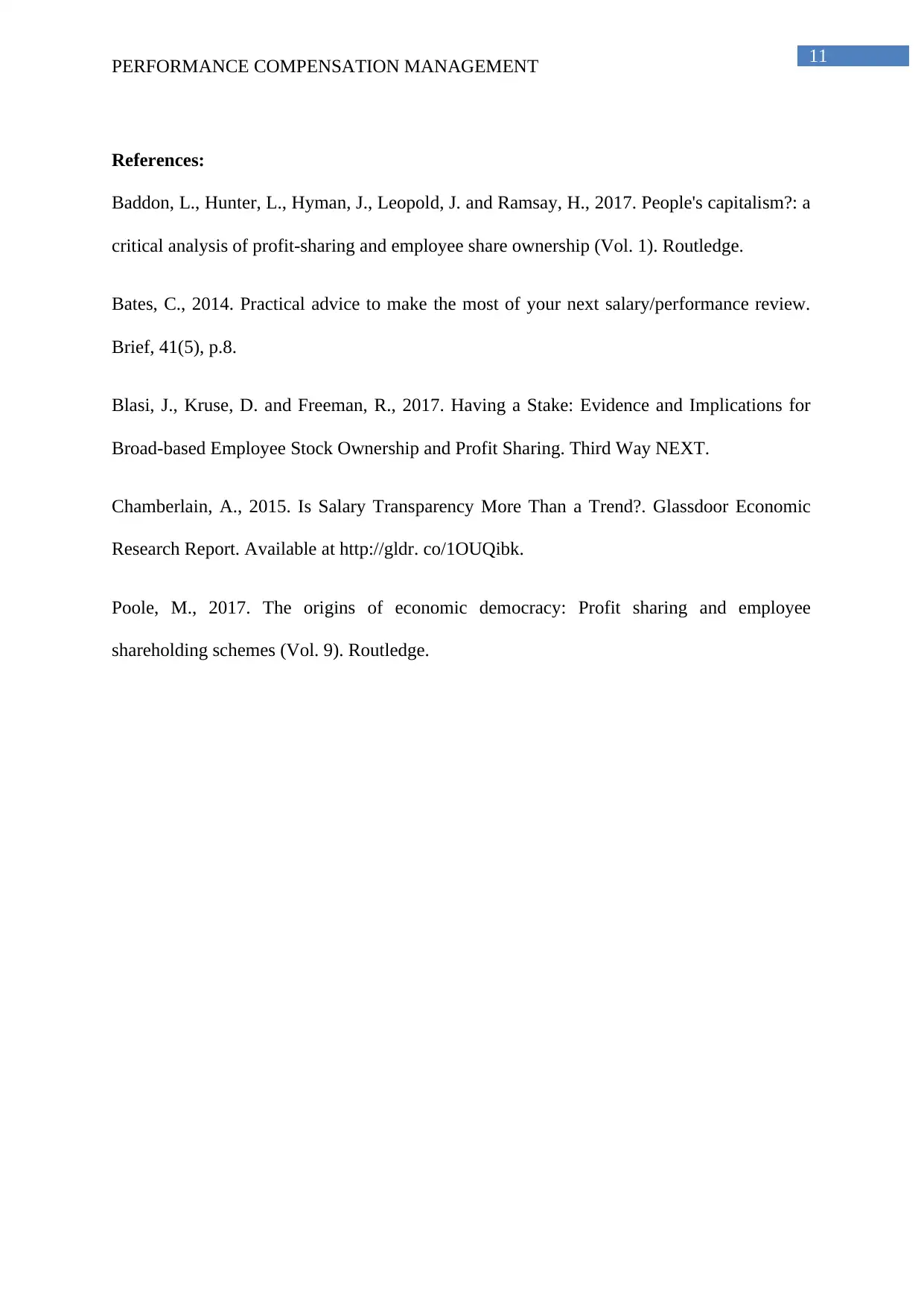
11
PERFORMANCE COMPENSATION MANAGEMENT
References:
Baddon, L., Hunter, L., Hyman, J., Leopold, J. and Ramsay, H., 2017. People's capitalism?: a
critical analysis of profit-sharing and employee share ownership (Vol. 1). Routledge.
Bates, C., 2014. Practical advice to make the most of your next salary/performance review.
Brief, 41(5), p.8.
Blasi, J., Kruse, D. and Freeman, R., 2017. Having a Stake: Evidence and Implications for
Broad-based Employee Stock Ownership and Profit Sharing. Third Way NEXT.
Chamberlain, A., 2015. Is Salary Transparency More Than a Trend?. Glassdoor Economic
Research Report. Available at http://gldr. co/1OUQibk.
Poole, M., 2017. The origins of economic democracy: Profit sharing and employee
shareholding schemes (Vol. 9). Routledge.
PERFORMANCE COMPENSATION MANAGEMENT
References:
Baddon, L., Hunter, L., Hyman, J., Leopold, J. and Ramsay, H., 2017. People's capitalism?: a
critical analysis of profit-sharing and employee share ownership (Vol. 1). Routledge.
Bates, C., 2014. Practical advice to make the most of your next salary/performance review.
Brief, 41(5), p.8.
Blasi, J., Kruse, D. and Freeman, R., 2017. Having a Stake: Evidence and Implications for
Broad-based Employee Stock Ownership and Profit Sharing. Third Way NEXT.
Chamberlain, A., 2015. Is Salary Transparency More Than a Trend?. Glassdoor Economic
Research Report. Available at http://gldr. co/1OUQibk.
Poole, M., 2017. The origins of economic democracy: Profit sharing and employee
shareholding schemes (Vol. 9). Routledge.
⊘ This is a preview!⊘
Do you want full access?
Subscribe today to unlock all pages.

Trusted by 1+ million students worldwide
1 out of 12
Related Documents
Your All-in-One AI-Powered Toolkit for Academic Success.
+13062052269
info@desklib.com
Available 24*7 on WhatsApp / Email
![[object Object]](/_next/static/media/star-bottom.7253800d.svg)
Unlock your academic potential
Copyright © 2020–2025 A2Z Services. All Rights Reserved. Developed and managed by ZUCOL.




